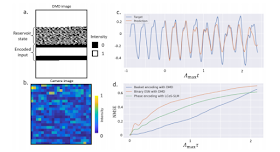Two new preprints using @LightOn's Optical Processing Unit. The first one shows a speed-up of 400 times faster than a CPU implementation. Both of these preprints used @LightOn's Optical Processing Unit. If you are interested in being part of our pilot program to have access to our Light Processing technology, please register at https://www.lighton.ai/lighton-cloud/ All papers and preprints utilizing our Light processing technology can be found at: https://www.lighton.ai/our-technology/
Optical Reservoir Computing using multiple light scattering for chaotic systems prediction by Jonathan Dong, Mushegh Rafayelyan, Florent Krzakala, Sylvain Gigan
Reservoir Computing is a relatively recent computational framework based on a large Recurrent Neural Network with fixed weights. Many physical implementations of Reservoir Computing have been proposed to improve speed and energy efficiency. In this study, we report new advances in Optical Reservoir Computing using multiple light scattering to accelerate the recursive computation of the reservoir states. Two different spatial light modulation technologies, namely, phase or binary amplitude modulations, are compared. Phase modulation is a promising direction already employed in other photonic implementations of Reservoir Computing. Additionally, we report a Digital-Micromirror-based Reservoir Computing at up to 640 Hz, more than double the previously reported frequency using a remotely controlled optical device developed by LightOn, and present new binarization strategies to improve the performance of binarized Reservoir Computing.
and another one, on making our Optical Processing Unit linear.
Don't take it lightly: Phasing optical random projections with unknown operators by Sidharth Gupta, Rémi Gribonval, Laurent Daudet, Ivan Dokmanić
In this paper we tackle the problem of recovering the phase of complex linear measurements when only magnitude information is available and we control the input. We are motivated by the recent development of dedicated optics-based hardware for rapid random projections which leverages the propagation of light in random media. A signal of interestξ∈RN is mixed by a random scattering medium to compute the projectiony=Aξ , withA∈CM×N being a realization of a standard complex Gaussian iid random matrix. Two difficulties arise in this scheme: only the intensity|y|2 can be recorded by the camera, and the transmission matrixA is unknown. We show that even without knowingA , we can recover the unknown phase ofy for some equivalent transmission matrix with the same distribution asA . Our method is based on two observations: first, changing the phase of any row ofA does not change its distribution; and second, since we control the input we can interfereξ with arbitrary reference signals. We show how to leverage these observations to cast the measurement phase retrieval problem as a Euclidean distance geometry problem. We demonstrate appealing properties of the proposed algorithm on both numerical simulations and in real hardware experiments. Not only does our algorithm accurately recover the missing phase, but it mitigates the effects of quantization and the sensitivity threshold, thus also improving the measured magnitudes.
all papers and preprints utilizing our Light processing technology can be found at: https://www.lighton.ai/our-technology/
Follow @NuitBlog or join the CompressiveSensing Reddit, the Facebook page, the Compressive Sensing group on LinkedIn or the Advanced Matrix Factorization group on LinkedIn
Other links:
Paris Machine Learning: Meetup.com||@Archives||LinkedIn||Facebook|| @ParisMLGroup< br/> About LightOn: Newsletter ||@LightOnIO|| on LinkedIn || on CrunchBase || our Blog
About myself: LightOn || Google Scholar || LinkedIn ||@IgorCarron ||Homepage||ArXiv


No comments:
Post a Comment